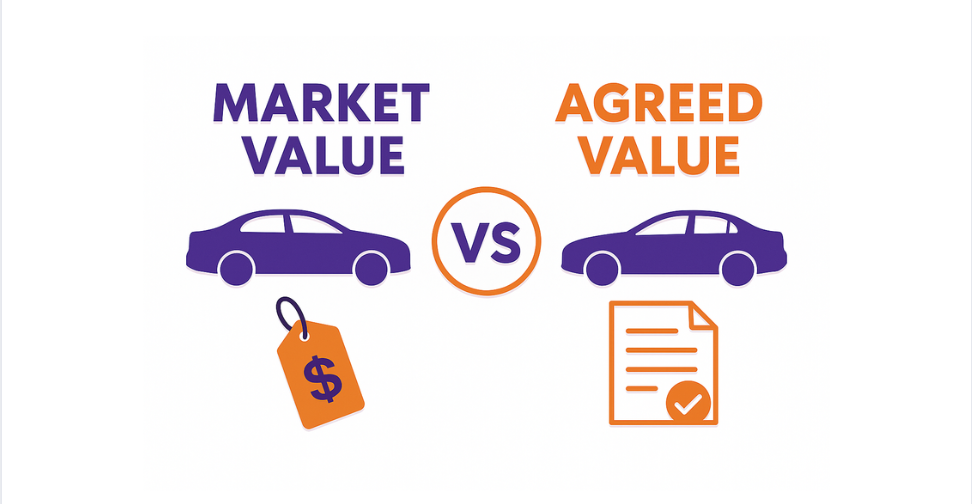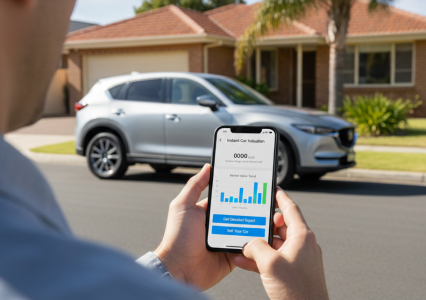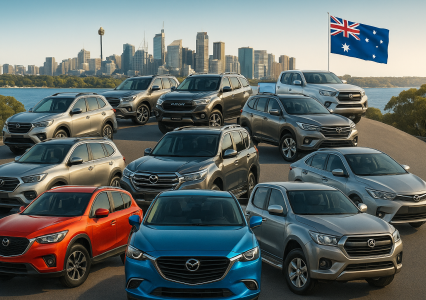Buying a car is one thing, but insuring it properly is another. One of the biggest points of confusion for car owners in Australia is the difference between market value and agreed value when it comes to car insurance.
You’ve probably come across these terms while comparing policies and wondered which one actually makes sense for you. Both options can affect how much your car is worth in the event of a claim, and how much you’ll be paying in premiums every month.
So, let’s break down what each one means, how they work, and when one might be better than the other.
What Is Market Value?
Market value is basically what your car would sell for in the current market, right before an accident or total loss. In other words, it’s the real-world value of your car at that time, not what you originally paid for it.
This value changes constantly, depending on things like:
- The make, model, and year of your car
- Its condition and mileage
- How many similar cars are selling for
- The general state of the used car market
For example, if you bought your car three years ago for $35,000, its market value today might only be around $22,000, depending on how well it’s held up and how much you’ve driven it.
When you insure your car for market value, your insurer decides how much it’s worth at the time of a claim. That value is usually based on market guides, sales data, and sometimes an assessor’s inspection.
What Is Agreed Value?
Agreed value, on the other hand, is a fixed amount you and your insurer both agree on when you take out your policy.
So instead of relying on fluctuating market conditions, you and the insurer decide upfront what your car is worth, say, $25,000, and that’s the amount you’ll receive if your car is written off or stolen (minus any applicable excess).
This agreed amount usually remains fixed for the term of your policy (often 12 months). However, when it’s time to renew, the insurer might reassess the value and offer a new agreed amount based on depreciation and current market data.
The Key Difference Between Market and Agreed Value
It all comes down to flexibility vs. certainty.
| Feature | Market Value | Agreed Value |
| Definition | The car’s value in the current market at the time of loss. | A set value agreed upon between you and your insurer at the start of your policy. |
| Value Changes | Yes, depends on depreciation and market trends. | No, remains fixed for the policy term. |
| Premium Cost | Usually cheaper. | Typically higher. |
| Claim Payout | Determined at the time of claim. | Predetermined, as stated in your policy. |
| Ideal For | Older cars or those with rapidly changing values. | New or special vehicles, or anyone who wants payout certainty. |
Why Some People Choose Market Value
Market value insurance tends to be the most common option because it keeps premiums lower. You’re basically letting the insurer decide your car’s worth at claim time, which means you’re trusting them to be fair, but you’re also saving money in the meantime.
This option makes sense if:
- You own an older or high-mileage car that’s already lost a good chunk of value.
- You’re on a budget and want cheaper premiums.
- You’re not too fussed about getting a fixed payout, as long as it’s close to your car’s resale value.
However, one thing to keep in mind is that the market value might not always match what you think your car is worth. Especially when the used car market fluctuates, the insurer’s calculation could come in lower than expected.
Why Others Prefer Agreed Value
If you like certainty, an agreed value gives you just that. You’ll know exactly what payout you’ll receive if your car is written off or stolen.
It’s particularly useful for:
- New or near-new cars, where you want to protect your investment.
- Special or rare models that may not have a clear market price.
- Cars with modifications or upgrades, since their market value might not reflect their actual worth.
Agreed value policies also tend to offer peace of mind. You won’t be arguing over numbers with your insurer after a loss; the value is already locked in.
The trade-off, though, is cost. Because the payout amount is guaranteed, insurers often charge higher premiums for agreed value cover.
How Insurers Calculate Market Value
If you’re wondering how insurers determine market value, it’s not just a random number. They typically use a mix of:
- Industry valuation databases (like Glass’s Guide or RedBook)
- Local sale listings for similar vehicles
- The car’s condition, odometer reading, and maintenance history
- Modifications or accessories that might affect resale value
If your car is written off, the insurer compares these factors to find a fair market value, essentially, what someone would reasonably pay for your car on the day before the incident.
What Happens When Your Car Is a Write-Off
Here’s where the difference between market and agreed value really matters.
If your car is written off:
- Market Value Policy: You’ll receive whatever the insurer determines is your car’s current worth, which might be less than what you expected.
- Agreed Value Policy: You’ll receive the exact amount agreed upon in your policy, giving you a clear idea of what you can afford for a replacement.
That certainty can make a big difference when you’re trying to get back on the road quickly after an accident.
Which Option Is Better for You?
There’s no universal answer; it depends on your situation.
Go for market value if:
- You want a lower insurance premium.
- You have an older car with limited resale value.
- You’re comfortable with some flexibility in payout amounts.
Choose the agreed value if:
- You have a new or unique car.
- You’ve added expensive modifications or accessories.
- You’d rather pay a bit more each month for a guaranteed payout.
A quick rule of thumb: if your car is worth less than $10,000 or over 10 years old, market value usually makes sense. For anything newer, rarer, or still under finance, agreed value might be the better option.
If you’re planning to buy a used car and still sorting out your finances, you can always check options through My Car Choice, where getting approved for the car loan is quick and straightforward.
Can You Change Between Market and Agreed Value?
Yes, but usually only at renewal time. Your insurer might allow you to switch from market to agreed value (or vice versa) when your policy is up for renewal. You’ll need to agree on a new value if you switch to agreed cover, or your premium will adjust if you move back to market value.
If your car has significantly changed in value, say you’ve added upgrades or the used car market has shifted, it’s a good idea to review this each year.
Which One to Choose?
Understanding the difference between market value and agreed value can save you from nasty surprises when it comes time to make a claim.
Market value gives you flexibility and keeps premiums affordable, but you might end up with less than expected if your car’s value drops. Agreed value costs a bit more, but it offers certainty and peace of mind when things go wrong.
At the end of the day, it’s about balance. Think about how much your car is worth, how much you’re willing to spend on insurance, and how comfortable you are with potential changes in value.
The Bottom Line
Whichever option you go with, the important thing is to know exactly what you’re covered for before you sign on the dotted line. Before finalising your finance and insurance, it’s worth visiting My Car Choice to compare deals and understand how your car’s value might affect your repayments down the line.



